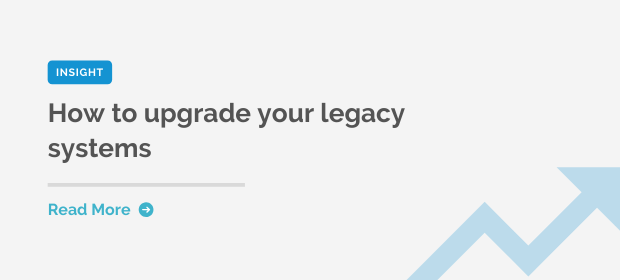Employee feedback and system workarounds are often signs that it’s time to invest in new tech. But when these systems are mission critical, how can you be confident that IT change will also deliver bottom-line growth? We explore why bottom-up feedback matters and the steps you can take to keep your employees happy and your business scalable.
What is Bottom-up Feedback and Why Does it Matter?
User feedback is direct or indirect employee activity that reveals your staff aren’t happy with the systems they’re using. If you’re lucky, employees will raise issues with you directly while still using your systems in the intended way. If you’re not so lucky, employees will find workarounds that make their lives easier while creating risk for your business.
Typically, workarounds are created when staff find systems don’t do what they need or when they find them too difficult to use. People then tend to turn to alternative methods such as spreadsheets.
An IFS survey found that 75% of under 35 and over half of respondents aged 36 to 45 turn to the comfort of spreadsheets when an enterprise solution is too difficult to use.
In one house building firm we worked with, staff created spreadsheets to manage each site plus additional spreadsheets that pulled data from each site spreadsheet to gain visibility and provide reporting. This created a big overhead, introduced risk and made it impossible to gain real-time visibility.
And those aren’t the only problems associated with stepping away from systems.
What Is the Risk In Ignoring User Feedback?
Security and GDPR risks
Systems enable data access to be controlled, working outside of the system doesn’t. This has implications for GDPR, particularly if staff are emailing spreadsheets to one another without adequate security. Sharing in this way also removes clarity of who has access to which data - within your organisation and externally - creating a risk under the GDPR.Reduced decision making capability
Information created outside of systems by workarounds and offline working has limited access and cannot be used. This restricts the accuracy and visibility of information within the system, limiting productivity rates and reducing the veracity of reporting, causing misinformed decision making. Decision making that could help you make significant improvements, reduce wastage and avoid issues like unplanned downtime.Processes aren’t followed properly
Systems often dictate processes and the data that’s gathered. Without them processes can be ignored resulting in a greater opportunity for risks. For example, if you need staff to complete health and safety information but it’s not being captured due to inefficient processes or hard to use systems, this could be a major risk for your business.Inefficiencies
Emailing spreadsheets and other forms of offline data relies on factors such as optimum version control to ensure everyone’s working from the latest record. Inevitably, people work form incorrect versions resulting in duplicated effort and inefficiencies and even lower service levels.
The good news is that when people create workarounds they want to do their jobs. Unfortunately, staff only interpret business need from their own organisational level. And it’s a view that often fails to deliver on leaders’ strategic vision.
Employee feedback is telling you that it’s time to invest in tech. It’s important to do this in a way that works for your people and helps them perform better while giving leaders what they need for optimal business performance.
How Can I Identify Options to Bridge the Gap?
Workarounds can be a major business risk. However, in identifying these risks, you can do something about them.
With workarounds already in place, you can see what employees need to make their lives easier. Talk to your staff to find out what else they’d like in their ideal systems scenario and combine it with your leaders’ strategic vision. Ask questions like:
- What would our systems need to look like to make your job easier or more efficient?
- How would our new systems deliver what the business, customers and employees need now?
- How will they be fit for purpose in the future for our organisation, clients and staff?
- How well do our systems integrate? Could we secure more business benefit with joined up systems?
With a high level idea about what you’d like your systems to do, you’re ready to take the next step in delivering systems that work for everyone.
Four Steps Towards the Best of Both Worlds
Experience shows that bottom-line growth can be enabled through the right systems as long as the correct process is followed. We recommend this four-step pathway to designing excellent systems that deliver.
1 - Secure insight
Involving the right people internally is critical as it will ensure you get insightful input and project buy-in. This will likely include members of your IT team, relevant managers and employees for a rounded view.
Take time to analyse and dig into organisational need. Workshops are a great option as they provide the granular detail required to define project requirements and build a roadmap for success.
2 - Map out existing systems
A detailed review of existing systems will identify any overlaps and workarounds and will reveal what works well and what doesn’t. Then it’s time to explore system need from the perspective of business processes including existing methods as well as any known business change. Armed with this insight you’ll have everything you need for a fit-for-purpose, future-proofed solution.
3 - Develop scenarios and create prototypes
The best systems projects define and establish common and not-so-common scenarios that the system will need to be able to deal with. A good way to ensure the project remains on track is to create prototypes early that:
- Provide a visual demonstration of your system’s workflows
- Can be tested by the people who will be using them
- Ensure the feasibility of advanced technical features like third party API integration
- Provide supporting materials for process analysis around complex product features
With the product in the hands of employees, you’ll get feedback quickly so it can be incorporated into the project and solutions found. And, with your guiding business needs in place, you’ll also ensure the outcome meet strategic needs too.
4 - Be transparent and communicate regularly
Keep everyone on the team updated so they have the information required to review progress, solve challenges, make decisions and keep the project moving forwards. Ongoing communications are also critical to building buy-in across your organisation. By keeping everyone outside the project team informed, you’ll create excitement and gain internal investment on your project - the key to a successful digital implementation.
By taking these steps, you’ll integrate bottom-up feedback with strategic business requirements resulting in systems that work for everyone. This will remove the risks associated with workarounds making your business more secure, efficient, productive and profitable.
Find out how Audacia helped ADM Agriculture create effective systems to combat workarounds and deliver a scalable platform to manage £500m grain transactions per year.




